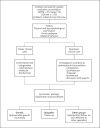Intellectual Disability in a Birth Cohort: Prevalence, Etiology, and Determinants at the Age of 4 Years
- PMID: 27595410
- PMCID: PMC5079101
- DOI: 10.1159/000448912
Intellectual Disability in a Birth Cohort: Prevalence, Etiology, and Determinants at the Age of 4 Years
Abstract
Background: Intellectual disability (ID), characterized by impairments in intellectual function and adaptive behavior, affects 1-3% of the population. Many studies investigated its etiology, but few are cohort studies in middle-income countries.
Aims: To estimate prevalence, etiology, and factors related to ID among children prospectively followed since birth in a Southern Brazilian city (Pelotas).
Methods: In 2004, maternity hospitals were visited daily and births were identified. Live-born infants (n = 4,231) whose family lived in the urban area have been followed for several years. At the age of 2 and 4 years, performances in development and intelligence tests were evaluated using the Battelle Developmental Inventory and Wechsler Intelligence Scale, respectively. Children considered as having developmental delay were invited to attend a genetic evaluation.
Results: At 4 years of age, the prevalence of ID was 4.5%, and the etiology was classified into 5 groups: environmental (44.4%), genetic (20.5%), idiopathic (12.6%), neonatal sequelae (13.2%), other diseases (9.3%). Most children presented impairment in two or more areas of adaptive behavior. There was no difference in prenatal care attendance or maternal schooling among the groups.
Conclusion: For about 40% of children, ID was attributed to nonbiological factors, suggesting that the rate may be reduced with appropriate interventions early in life.
© 2016 The Author(s) Published by S. Karger AG, Basel.
Figures
References
-
- Schalock RL, Borthwick-Duffy SA, Bunthix WHE, Coulter DL, Craig EPM. Intellectual disability: definition, classification, and systems of supports. Washington: American Association on Intellectual and Developmental Disabilities; 2010.
-
- Flore LA, Milunsky MJ. Updates in the genetic evaluation of the child with global developmental delay or intellectual Disability. Seminar Pediatr Neurol. 2012;19:173–180. - PubMed
-
- Bergen DC. Effects of poverty on cognitive function: a hidden neurologic epidemic. Neurology. 2008;71:447–451. - PubMed
-
- Centers for Disease Control and Prevention (CDC) Economic costs associated with mental retardation, cerebral palsy, hearing loss, and vision impairment - United States, 2003. MMWR Morb Mortal Wkly Rep. 2004;53:57–59. - PubMed
MeSH terms
Grants and funding
LinkOut - more resources
Full Text Sources
Other Literature Sources
Medical


